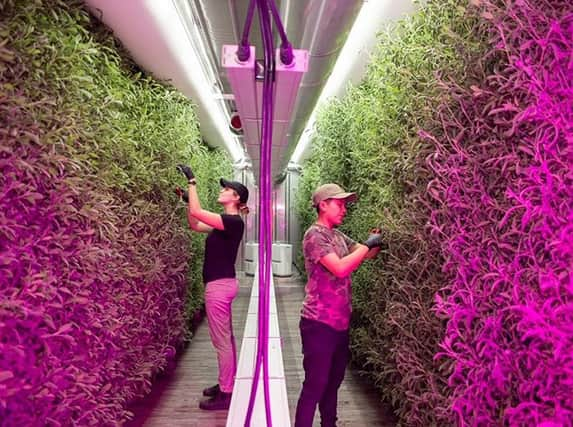Urban agriculture can boost rural food production - Stephen Fox


While Scotland is well placed to get ahead of the curve, there is an urgent need for leadership, guidance and a strategic approach from the Scottish Government, its development agencies and our civic leaders to secure this lead.
Covid-19 has highlighted the vulnerability of supply chains for fresh produce and given impetus to developing new ways to increase localised food production – and by doing so, reducing “food miles” and increasing environmental sustainability.
Advertisement
Hide AdAdvertisement
Hide AdConsumers are becoming more interested and aware of the importance of supporting both of these aspects when choosing their produce. Exciting new developments in the horticultural industry are making use of the latest technologies in controlled environment agriculture for producing food in urban areas.
80 per cent of the population of Scotland live in cities and towns, but virtually all our food supplies come from rural areas or are imported. In particular, we rely heavily on imports for fresh fruit and vegetables.
Embracing urban agriculture and developing a strategy and vision on how it could be taken forward in Scotland is now urgently needed to meet the coming challenges to food security.
North America and Southeast Asia (Singapore and Japan) are ahead of Europe in innovations and uptake of high-tech urban agriculture. The drive has come from the latest innovations in growing techniques e.g. hydroponics and LED lighting as a source of energy for efficient light for growing indoors.
However, there are some interesting recent major European projects. Agropolis Paris spans 14,000 m2 making it the largest urban farm in Europe producing around 1,000kg of fruit and vegetables daily, using entirely organic methods. Roeselare in Belgium has just opened a fully closed rooftop greenhouse built on top of a food market hall.
One innovative Scottish company is already embracing these changes in food security. East Lothian based Agron-Pod uses hydroponic technology and expert LED lighting to grow high value, nutritionally rich microgreens, leafy greens, herbs, veggies, fruits, edible flowers and medicinal plants, inside a modular indoor farm system or utilising existing infrastructure. The Pods are custom-designed to the farmer’s specifications, utilising the latest in horticultural technology to assure the highest yield. They are vandal-proof and equally suited to use on derelict or abandoned land in urban areas or in remote and island locations.
We need to enhance the capability of food technology within urban spaces, covering the quality and safety of food, and to develop capacity in efficient resource use to achieve a circular economy – and it is essential to make the best use of public spaces - including abandoned and neglected ones.
The successful adoption of urban agriculture, however, requires more than implementing the technical systems, it also requires changes to the way in which cities and city systems are planned and implemented to include wider elements such as biodiversity maintenance and social sustainability. It also means gaining a better understanding of human interaction with city planning and governance - changing the way that citizens and policy makers think about their food supply and their city
Advertisement
Hide AdAdvertisement
Hide AdThe challenges include integration of different types and approaches providing the mechanisms and providing the financial support necessary to turn the latest innovations into commercial and profitable activity. There is also a need for city-wide spatial planning and policies incorporating urban agriculture in future strategic plans.
In conclusion, effective public policy on urban agriculture needs to cover:
*Technology and Innovation by showcasing innovations through public funded support for pilot demonstration projects taking up the latest innovations in different technologies and systems e.g. rooftop, open air, indoors, hydroponics LED lighting, circularity and resource efficiency.
*The promotion of the environmental and sustainability advantages of less land use, reduced chemical and pesticide usage, CO2 savings and the contributions such an approach will make towards zero carbon and zero waste goals and mitigating the urban heat island effect. The integration of renewable energy e.g. solar panels should also be key design feature.
*Not all motivations are driven by commercial and economic considerations and society health and wellbeing should also be important considerations. The social benefits for health and promote well-being for all ages not only through healthy diet but also by being physically and mentally active in gardening, socialising and learning should also be recognised.
Stephen Fox is a former civil servant with the Scottish Government and now an adviser to Harper Adams University
Comments
Want to join the conversation? Please or to comment on this article.